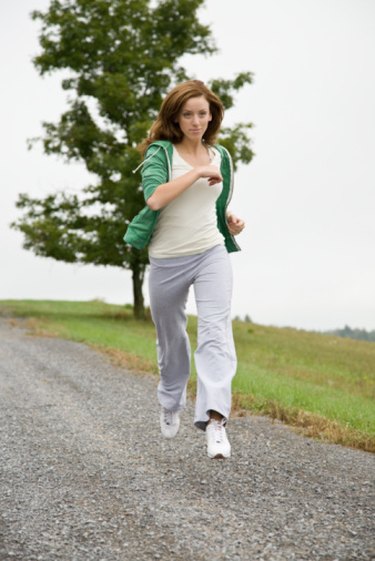
If you develop sore chest muscles 24 to 48 hours after running, the cause may be delayed onset muscle soreness, or DOMS. DOMS usually vanishes within five to seven days and can be eased with self-care, but MayoClinic.com says that you should consult your doctor if your muscle pain lasts longer than a week, if you notice redness and swelling around the muscles, or if the pain started after beginning a new medication. If you have extreme muscle weakness, trouble breathing, dizziness or high fever and a stiff neck, seek immediate medical care.
Features
Video of the Day
DOMS causes muscle pain, inflammation, stiffness and muscle weakness. Severity of symptoms can range from mild achiness to debilitating pain and stiffness that can compromise functional ability for up to a week. Strenuous exercise -- such as lifting weights and bicycling or running for long distances -- increases your chances of having DOMS. Doctors used to attribute DOMS to lactic acid buildup in the blood, but this theory has fallen out of favor. Sports Fitness Advisor says that DOMS is now believed to be an inflammatory response to the microscopic tears that occur in muscle tissue with strenuous exercise. The website also says that research has shown that white blood cell count increases after vigorous exercise. The cycle of tearing and healing of muscle tissue eventually strengthens and enlarges the muscles.
Video of the Day
Treatment
Sports Injury Bulletin advises massage to relieve pain and swelling and says that a protease supplement may be helpful. Pain and swelling can be alleviated with over-the-counter anti-inflammatory medications, as long as you have no conditions that preclude their use. MayoClinic.com advises that the best remedy for DOMS may be moderate exercise, with "moderate" being the key word. Exercising strenuously when muscles are already sore could be counterproductive and delay recovery. Avoid sprinting and running downhill, both of which increase chances of DOMS. A short, gentle run is a much better option.
Prevention
Avoiding overtraining is the best way to prevent DOMS. Beware of sudden and excessive increases in the frequency, intensity or duration of your workouts, and warm up and cool down properly before and after sessions. Some runners believe that taking 500 mg of vitamin C before workouts can help prevent DOMS. While Sports Fitness Advisor credits vitamin C -- a potent antioxidant -- with helping to repair connective tissue, the website says that clinical trials haven't confirmed its effectiveness for DOMS. Consult your doctor before taking vitamin C for DOMS.
Research
There is some clinical evidence that non-steroidal anti-inflammatory medications relieve the pain of delayed onset muscle soreness. In a double-blind, placebo-controlled trial published in the July 2003 issue of "Clinical Journal of Sports Medicine," 34 healthy men underwent a series of leg extension and flexions designed to bring on DOMS, then were treated with topically applied ketoprofen, an NSAID sold under the trade name Orudis. Researchers found that the medication significantly improved symptoms of DOMS.